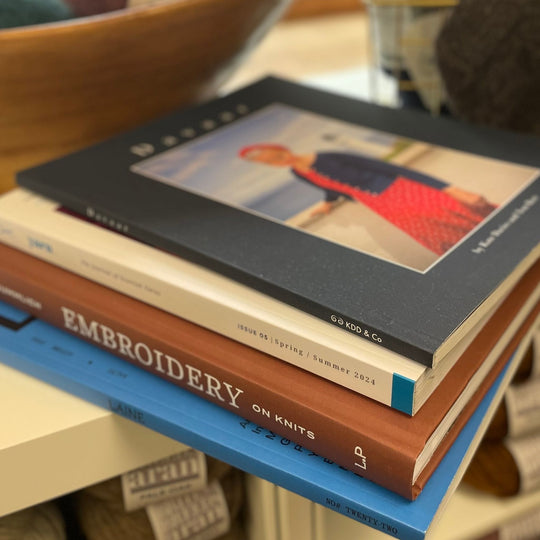Caring for your Woolly Handknits
After you’ve knit a project that has taken skeins of yarn and hours of your time and effort, you want to make sure it looks as good as it can for as long as possible. At The Woolly Thistle, we want you to love your projects, so we’ve put together this short guide on how to care for your wooly pieces.
BLOCKING

The last step in most projects is blocking. Blocking is a knitting-specific term for washing your finished project and letting it dry in a way that maximizes its design. Generally, the two steps are simple: wash and dry.
Wash:
1. Fill a large bowl, basin, bucket, or tub with lukewarm water.
2. Add a few drops (not more!) of a wool-specific wool wash like Eucalan or a gentle dish soap like unscented Dawn and swish to distribute.
3. Sink your knitting into the water, being careful not to agitate it but making sure it’s fully submerged.
4. Let soak for 15-30 minutes, depending on the thickness of the project (or the time you have!)
5. Support under the project and lift out of the water. Letting it hang can stretch out the wool, so make sure you’re holding underneath. Squeeze to remove water, but don’t wring.
Dry:
6. Lay the project flat on a towel (that you don’t mind getting dye on, in case it bleeds a little) flat on the ground or on a table.
7. Roll up the towel with the project inside. Step on the rolled towel to remove more water.
8. Unroll the towel and remove the project.
9. Place the project on a dry towel, a plastic sheet or garbage bag, or other flat surface.
10. For projects that have lace stitches or need to be stretched to a particular size, use pins,
wires, or blocking combs to stretch out the project to desired shape or size. This can be done into blocking mats or even into floor carpet with underlay.
11. For most projects, lay the project flat and smooth out to approximate size.
12. Let dry.
When dry, your project should be washed of any residual dye, spinning oil, residue from your hands or where you’ve been knitting it, or anything else. The yarn will have bloomed and the stitches may have filled in and fluffed up a bit.
CARE

Many wool pieces will require a bit of routine care to keep them looking their best. You may need to re-block your pieces occasionally, but often this doesn’t need to happen frequently.
Wool has anti-microbial properties, so many sweaters can be washed seasonally. Socks should be washed more frequently, but every wear (or even every 5 wears) isn’t necessary. Many accessories (hats, shawls, cowls, etc.) may only need to be washed when soiled.
Most wools will pill to some extent at some point, with the wooly wools sold by The Woolly Thistle much less than many merino wools. Pills appear at high-friction areas like underarms, on the sides of the body where arms brush by, and on sweater forearms. Never fear! De-pilling can be as simple as picking off a few stray pills or using a razor to gently shave them off. Tools like the Gleaner can speed up the process.
STORAGE
Wool can fall victim to moths but this issue is far less common than it may seem. Moths are actually attracted to the smell of sweat, not wool itself, so washing your garments before storing can prevent moth issues. You can also repel moths with lavender sachets or small blocks of cedar wood.



























Thank you for this. I have been concerned that I was missing something in my blocking but I do as you describe. Many thanks!
Leave a comment